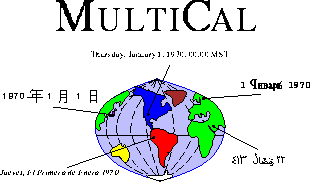
|
| Temporal Indeterminacy |
| Fast I/O | |
| Granularity | |
| Indeterminacy | |
| MultiCal | |
| Now | |
| TADT | |
| Timestamps | |
| TSQL2 | |
| Curtis Dyreson | |
| Home | |
| Publications | |
| Projects | |
| Software | |
| Demos | |
| Teaching | |
| Contact me | |
This is joint research with Professor Richard T. Snodgrass.
Temporal indeterminacy means don't know when information. The research described here investigates how to support this kind of information in a temporal database. The C code to implement and test indeterminacy can be obtained here.
C codeBelow are publications that were produced during the investigation.
- Curtis E. Dyreson and Richard T. Snodgrass. Supporting Valid-time Indeterminacy. ACM Transactions on Database Systems, 23(1), March 1998, pp. 1-57. DBLP Electronic edition
- Curtis E. Dyreson and Richard T. Snodgrass. Valid-time Indeterminacy. In Proceedings of the Ninth International Conference on Data Engineering (ICDE), Vienna, Austria, April 1993, pp. 335-343. Winner of Best Paper Award. PDF
- Curtis E. Dyreson and Richard T. Snodgrass. Temporal Indeterminacy. In The TSQL2 Temporal Query Language. Richard T. Snodgrass, editor. Kluwer Academic Press, 1995. pp. 325-344. DBLP Electronic Edition
- Curtis E. Dyreson. Temporal Indeterminacy (U. of Arizona Dissertation) PDF I must warn the casual reader that the dissertation is in Arizona dissertation style which is double spaced (the horror!).
In valid-time indeterminacy, it is known that an event stored in a temporal database did in fact occur, but it is not known exactly when the event occurred. We extend a tuple-timestamped temporal data model to support valid-time indeterminacy and outline its implementation. This work is novel in that previous research, although quite extensive, has not studied this particular kind of incomplete information. To model the occurrence time of an event, we introduce a new data type called an indeterminate instant. Our thesis is that by representing an indeterminate instant with a set of contiguous chronons and a probability distribution over that set, it is possible to characterize a large number of (possibly weighted) alternatives, to devise intuitive query language constructs, including schema specification, temporal constants, temporal predicates and constructors, and aggregates, and to implement these constructs efficiently. We extend the TQuel and TSQL2 query languages with constructs to retrieve information in the presence of indeterminacy. These constructs allow users to specify their credibility in the underlying valid-time data and their plausibility in the relationships among that data. Although the extended data model and query language provide needed modeling capabilities, these extensions appear to carry a significant execution cost. An important contribution of this research is to demonstrate that our approach is useful and practical. The cost of support for indeterminacy is empirically measured, and is shown to be modest.
We then show how indeterminacy can provide a much richer modeling of
granularity and now.
Granularity is the unit of measure of a temporal datum
(e.g., days, months, weeks).
Indeterminacy and granularity are two sides of the same coin insofar
as a time at a given granularity is indeterminate at all finer granularities.
now is a distinguished temporal value.
For example, a birthdate, given to the granularity of days,
does not reveal precisely when a person was born, only
that they were born sometime during the indicated day.
Indeterminacy also provides a richer modeling of now.
We describe a new kind of instant, a now-relative indeterminate
instant,
which has the same storage requirements as other instants, but
can be used to model situations such as that an employee is currently
employed but will not work beyond the year 1995.
Currently, no other timestamp can model this kind of temporal information.
In summary, support for indeterminacy dramatically increases the modeling
capabilities of a temporal database without adversely impacting performance.
Curtis E. Dyreson © 1993-2001. All rights reserved.